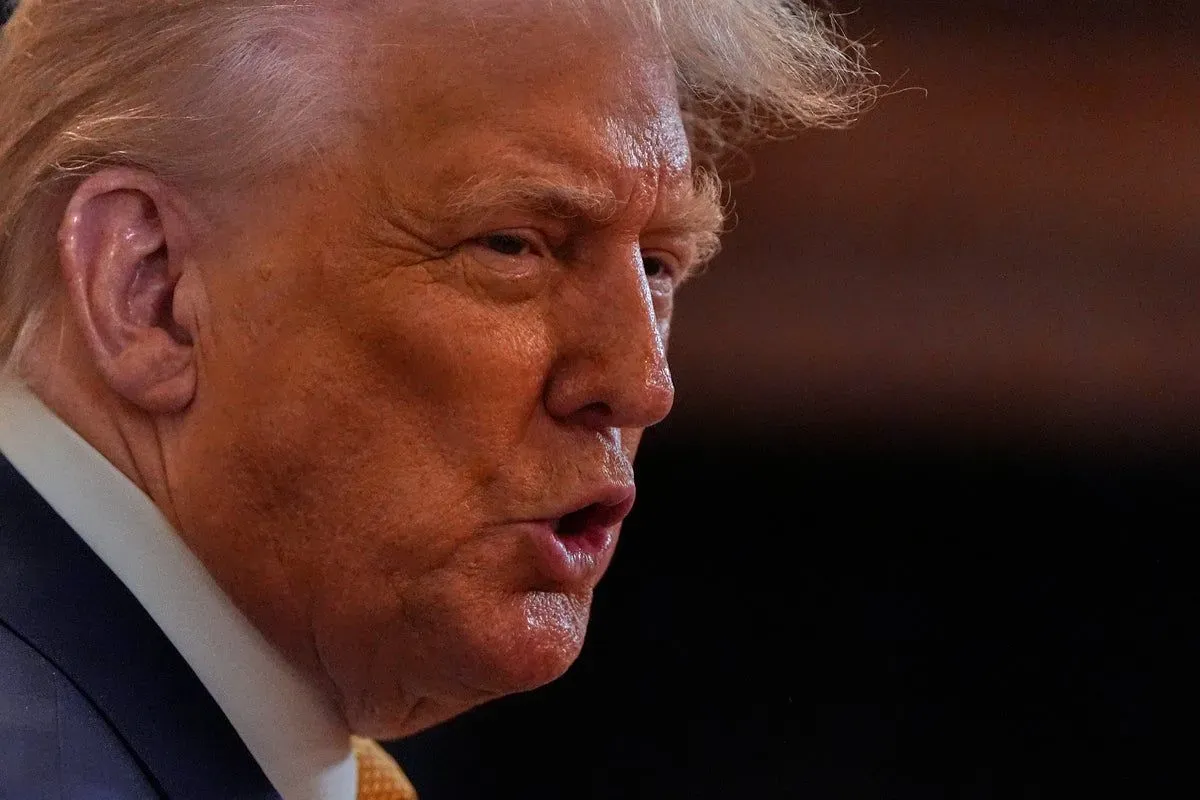In a bold move to reshape the landscape of artificial intelligence (AI) in the United States, President Donald Trump has unveiled his much-anticipated AI action plan. This comprehensive strategy aims to strip away existing regulations that hinder the growth of AI technology, positioning the U.S. as a frontrunner in global AI leadership. With a focus on accelerating AI innovation and enhancing AI infrastructure, the plan seeks to establish America as the go-to hub for advancing artificial intelligence policies. As the competition heats up, Trump emphasizes the importance of developing a robust AI ecosystem that will not only set standards but also generate significant economic and military advantages for the country. By prioritizing these actions, the Trump AI action plan endeavors to ensure that the United States claims victory in the international AI race.
Recently, the administration has introduced a comprehensive framework designed to propel the U.S. into the forefront of the artificial intelligence domain. This multi-faceted initiative aims to cut through cumbersome regulations and employs a strategic focus on fostering innovation within the AI sector. By enhancing the country’s technological infrastructure and establishing robust AI-related policies, the initiative provides a clear roadmap on how to secure a competitive edge in AI developments. Additionally, the emphasis on international collaboration and the establishment of partnerships is seen as crucial for promoting American values in the global AI landscape. Through these concerted efforts, the aim is to create an environment conducive to nurturing groundbreaking advancements in AI technology.
Understanding Trump’s AI Action Plan
President Trump’s AI action plan is a comprehensive strategy aimed at establishing the United States as a global leader in artificial intelligence. Titled “Winning the Race: America’s AI Action Plan,” the document emphasizes the importance of reducing regulations that currently hinder AI development. The initiative seeks to not only align the American innovation landscape with current technological advancements, but also to set the stage for future AI leadership by creating a conducive environment for AI innovation. This proactive approach, as articulated in the plan, corresponds with national interests in economic growth and military superiority.
The US AI leadership vision outlined in the action plan not only focuses on domestic growth but highlights the urgent need for international collaboration. By fostering partnerships with like-minded nations and exporting American AI technologies, the plan proposes a framework within which the US can exert influence over global AI standards, similar to past technological races. With a clear direction, the strategy emphasizes the importance of agility in policy-making to ensure that AI continues to thrive while balancing regulatory oversight with freedom of innovation.
Pillar I: Accelerating AI Innovation
The first pillar of Trump’s AI action plan, centered on accelerating AI innovation, sets forth a clear directive to dismantle regulatory barriers that impede technological growth. This strategic focus highlights the critical nature of allowing the US private sector to thrive without being bogged down by unnecessary bureaucratic constraints. The call for revising or repealing existing regulations underscores a comprehensive commitment to ensuring that American AI development remains competitive on a global scale. In an era where AI innovation is pivotal, the removal of red tape is not merely advantageous but essential.
Furthermore, the action plan details the potential consequences for states imposing overly burdensome regulations by threatening to diminish their access to federal funding. This holds states accountable to maintain a balance between fostering innovation while respecting prudent legal frameworks. The emphasis on constructing AI systems that uphold values such as freedom of speech and objective truth directly responds to concerns about the ideological bias in technology, reflecting a commitment to developing AI that serves the public fairly and equitably.
Pillar II: Building American AI Infrastructure
The second pillar of Trump’s AI action plan focuses on enhancing the infrastructure necessary to support AI growth in the United States. Acknowledging that American energy capacity has stagnated, the plan outlines steps to accelerate infrastructure projects crucial for establishing dominance in the AI field. This includes streamlining environmental permit processes, particularly under regulations that hinder the development of AI data centers. By boosting energy capacity and efficiency, the US aims to provide the robust and flexible framework necessary for advancing AI technologies.
Moreover, the plan signifies a shift towards modernizing the nation’s electric grid as a foundational step in bolstering AI infrastructure. Upgrading this critical system not only supports data centers but also ensures a sustainable energy supply conducive to AI operations. By prioritizing infrastructure improvements, the action plan reinforces its goal of positioning the U.S. as a leader in innovative AI technologies, ensuring that the country is equipped to handle future demands of the AI industry.
Pillar III: Leading in International AI Diplomacy and Security
The third pillar emphasizes the significance of not only fostering AI within the US borders but also promoting American AI technologies on a global scale. The action plan advocates for a strategic approach to international diplomacy, suggesting that the US should export its full range of AI technologies, which includes hardware and software solutions, to allied nations. By doing so, the plan aims to forge international alliances that are beneficial for not only economic growth but also for establishing global norms in AI governance that reflect American values.
Additionally, the action plan critiques current international bodies and their proposed governance frameworks, arguing that they often promote regulatory burdens that conflict with the US approach to innovation. This indicates a clear intention to drive a narrative where AI developments align with principles that encourage freedom and creativity, countering authoritarian influences from other nations. By leveraging its global position, the US strategy seeks to reshape international dialogues surrounding AI, fostering a landscape that prioritizes innovation and ethical standards.
AI Regulations: Finding the Balance
Navigating AI regulations is crucial to realizing the full potential of artificial intelligence technologies. The Trump Administration’s approach, as laid out in its action plan, seeks to reduce regulatory complexities to enhance innovation. However, this balancing act between necessary oversight and fostering a pro-innovation environment remains a pivotal discussion within AI policymaking. Striking the right balance ensures that while innovation thrives, public safety and ethical considerations are not overlooked.
Crucially, the action plan outlines a vision for AI regulations that are adaptable and supportive of emerging technologies. This means revisiting existing frameworks to eliminate those that might stifle progress, thereby creating a sustainable environment for AI growth. By encouraging proactive and flexible regulations, stakeholders can collaborate to craft policies that safeguard societal interests while promoting an ecosystem that accelerates technological advancements.
The Future of US AI Leadership
As the world increasingly turns its focus towards artificial intelligence, the trajectory of US AI leadership will depend heavily on the successful execution of the strategies outlined in the Trump Administration’s action plan. By emphasizing the need for cutting-edge infrastructure and a regulatory environment conducive to innovation, the US positions itself assertively on the global stage. Sustaining this leadership role will require rigorous engagement with international partners and continuous assessment of the evolving AI landscape.
The vision of being at the forefront of AI technology is rooted in economic and strategic imperatives. Therefore, nurturing homegrown talent, investing in research and development, and actively participating in global AI discourses will be essential for the United States to retain its competitive advantage. By committing to this comprehensive action plan, the country can ensure its lasting influence and relevance in shaping the future of artificial intelligence and its implications for society.
AI Infrastructure Investments: A National Imperative
Investing in AI infrastructure is not just a strategic initiative but a national imperative that can redefine the technological landscape of the United States. With the rapid advancements in AI technologies, modernizing infrastructure such as data centers, energy grids, and connectivity networks is crucial to supporting the growing needs of AI applications. Trump’s action plan recognizes this necessity and proposes measures to fortify the country’s technological backbone to foster innovation.
These investments in AI infrastructure not only enhance institutional capabilities but also drive economic growth by creating jobs and opportunities across various sectors. As the plan indicates, ensuring a robust AI infrastructure paves the way for increased efficiency and effectiveness in developing AI technologies. Thus, prioritizing infrastructure development is a foundational step toward reclaiming and maintaining the United States’ status as a global leader in artificial intelligence.
AI International Diplomacy: Building Strategic Alliances
AI international diplomacy is critical as countries around the world seek to establish their own AI frameworks and standards. Trump’s action plan emphasizes the necessity for the United States to lead this discourse internationally. By actively engaging with other nations through technology exports and shared technological initiatives, the US can build strategic alliances that further consolidate its position as a leader in AI development.
Such collaborative efforts not only serve to promote American values but also set a precedent for global AI governance that mitigates the influence of authoritarian regimes. Engaging in bilateral and multilateral discussions on AI standards can foster a more cohesive approach to AI innovation, ensuring that the values underpinning American AI policies resonate on a global scale. This strategic diplomacy can ultimately shape the future of international AI applications, creating an ecosystem centered around innovation and shared ideals.
Navigating the Global AI Landscape: Challenges and Opportunities
Navigating the global AI landscape presents both challenges and opportunities for the United States. As countries develop their own AI capabilities, there is a pressing need for the US to adapt its strategies to remain competitive. The action plan outlines a vision for overcoming these challenges by encouraging collaborative ventures with allied nations and fostering an environment of innovation that is resilient to global changes.
However, these opportunities come with the responsibility to guide AI development ethically and equitably. As the US seeks to lead the global conversation on AI standards, it must remain vigilant against rising regulatory regimes that may impede progress. By championing innovation while advocating for balanced governance practices, the United States can set the tone for international AI interactions, ensuring that advancements in technology contribute positively to society.
Frequently Asked Questions
What are the key components of the Trump AI action plan?
The Trump AI action plan, titled ‘Winning the Race: America’s AI Action Plan,’ focuses on three main pillars: accelerating AI innovation, building AI infrastructure in the U.S., and ensuring U.S. leadership in global AI. The plan emphasizes reducing regulations that hinder AI development and outlines actions the federal government should take to enhance America’s position in artificial intelligence.
How does the Trump AI action plan propose to accelerate AI innovation?
To accelerate AI innovation, the Trump AI action plan calls for the removal of regulatory barriers that impede the development and deployment of AI technologies. It suggests federal agencies revise or repeal unnecessary regulations and threatens to limit federal funding to states with overly burdensome AI laws.
What steps are included in the Trump AI action plan to improve AI infrastructure?
The Trump AI action plan aims to build American AI infrastructure by streamlining environmental regulations that slow down projects, especially related to energy capacity. It recommends fast-tracking permitting processes for major AI infrastructure projects to support the growth of AI data centers in the U.S.
How does the Trump AI action plan affect U.S. AI leadership on a global scale?
The plan asserts that to maintain U.S. leadership in artificial intelligence, it is crucial to actively promote American AI technologies worldwide. This includes exporting the full AI technology stack to allied countries and advocating against international governance frameworks that impose regulations contrary to American values.
What are the implications of the Trump AI action plan regarding regulatory changes?
The Trump AI action plan implies significant regulatory changes to facilitate AI development in the U.S. It seeks to eliminate references in existing frameworks that promote ideologies not aligned with innovation and calls for the federal government to support only AI solutions that are free from political bias.
How does the Trump AI action plan address the concerns about AI safety regulations?
The Trump AI action plan targets the rollback of safety regulations established by previous administrations. It aims to replace them with a framework that emphasizes innovation and growth in AI technology while ensuring that federal contracts go only to AI models that are free from ideological bias.
What role does international cooperation play in the Trump AI action plan?
International cooperation is regarded as vital in the Trump AI action plan, which states that the U.S. must lead efforts to promote American AI systems globally. The plan encourages forming alliances with like-minded nations to enhance global standards while opposing restrictive regulations influenced by entities like the United Nations.
What actions does the Trump AI action plan suggest for promoting American AI models abroad?
The Trump AI action plan suggests that U.S. officials should actively promote the export of American AI models and technologies. It emphasizes leveraging the U.S.’s unique position to advocate for its AI standards and encourage international partnerships that align with American technological values and approaches.
Is the Trump AI action plan focused on private sector innovation?
Yes, the Trump AI action plan prioritizes private sector innovation by proposing that bureaucratic red tape be minimized. It asserts that a robust private sector is essential for America’s global leadership in AI and emphasizes the need for federal policies that foster an unencumbered environment for AI development.
What changes to AI contracting practices does the Trump AI action plan recommend?
The Trump AI action plan recommends that the federal government should only contract with AI developers whose technologies are free from partisan bias. This policy aims to ensure that government-affiliated AI systems are objective and promote fairness without ideological influences.
| Key Points | Details |
|---|---|
| Pillar I: Accelerate AI Innovation | Recommendations include removing bureaucratic obstacles and ensuring regulations do not hinder AI development. Emphasizes freedom of speech in AI systems. |
| Pillar II: Build American AI Infrastructure | Focus on improving energy capacity and regulatory frameworks to support AI infrastructure growth. Suggests fast-tracking environmental permits and upgrading the electric grid. |
| Pillar III: Lead in International AI Diplomacy and Security | Advocates for the global adoption of American AI technologies and standards. Calls for collaboration with like-minded nations while opposing international regulations that go against U.S. values. |
| Executive Orders | Trump signed three orders to fast-track AI projects, promote international exports, and ensure the federal government only uses unbiased AI technologies. |
Summary
The Trump AI action plan outlines a strategic approach to position the U.S. as a leader in artificial intelligence by significantly reducing regulations. With a focus on innovation, infrastructure, and international collaboration, the plan aims to eliminate barriers hindering AI development while promoting American values globally. By implementing these measures, the Trump Administration seeks to ensure that the U.S. remains at the forefront of the AI race, ultimately aiming for economic and military advantages in this vital technology sector.



